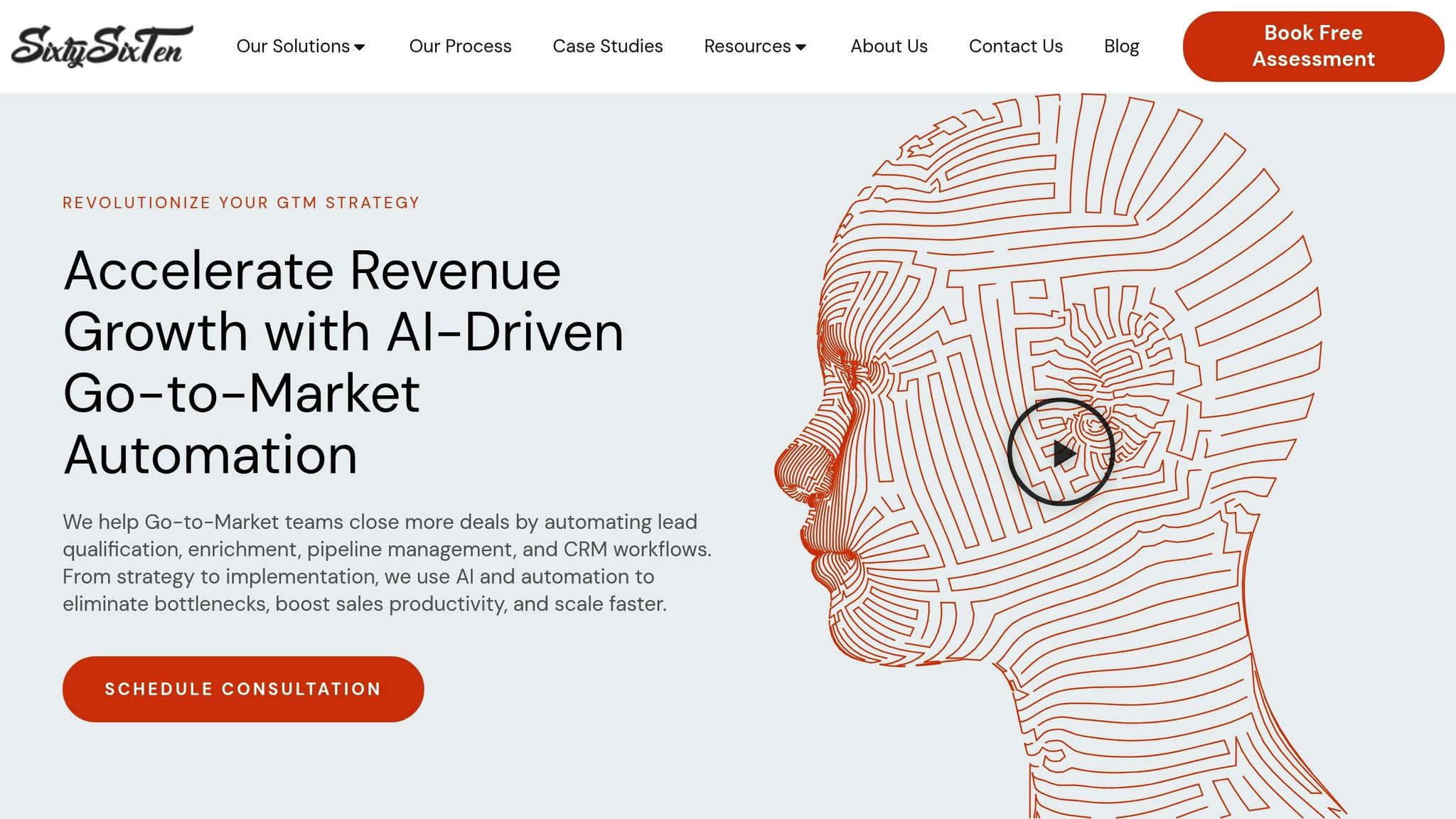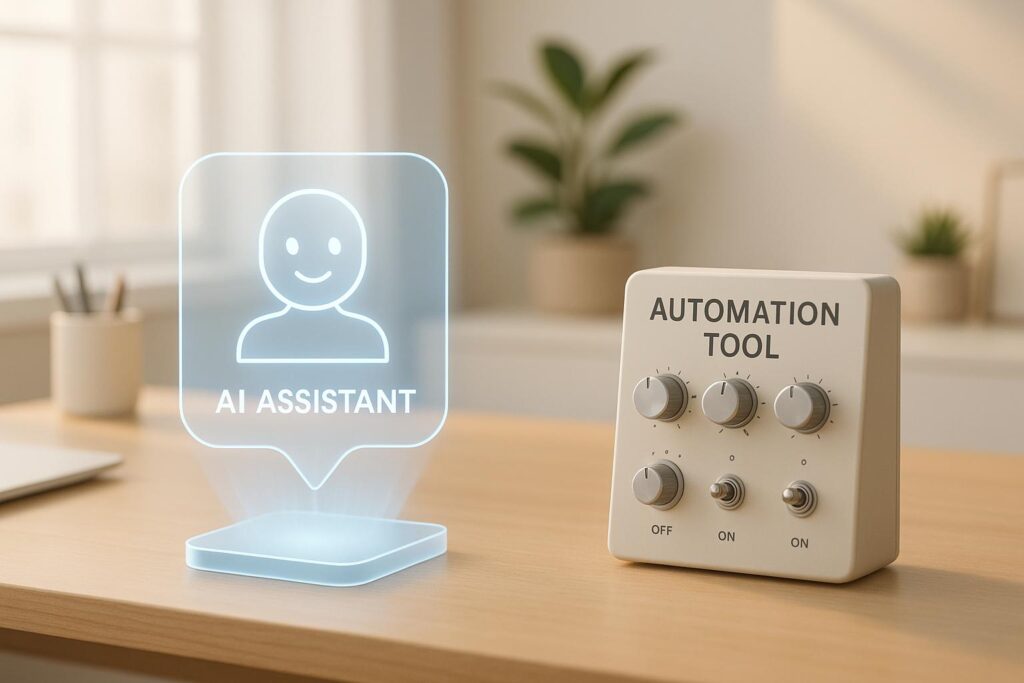AI agents and traditional automation tools both automate tasks, but they work differently. Traditional tools follow fixed rules and handle structured, repetitive workflows, like updating CRMs or sending automated emails. AI agents, however, use machine learning to process unstructured data and make context-sensitive decisions, such as researching prospects or scoring leads dynamically.
For B2B SaaS companies, the smartest approach is to combine both: use traditional tools for predictable processes and AI agents for more complex, data-rich tasks. This balance improves efficiency and scalability.
Key Takeaways:
- Traditional Automation: Best for structured, repetitive tasks (e.g., CRM updates, email triggers).
- AI Agents: Ideal for unstructured, dynamic tasks (e.g., lead research, personalized outreach).
- Integration: Combining both methods with platforms like Zapier or Clay enhances workflows.
Quick Comparison:
| Aspect | Traditional Automation | AI Agents |
|---|---|---|
| Data Handling | Structured data only | Structured + unstructured data |
| Flexibility | Fixed workflows | Dynamic, goal-driven workflows |
| Learning | No learning capability | Learns and improves over time |
| Maintenance | Frequent manual updates needed | Minimal monitoring and retraining |
By leveraging the strengths of both approaches, businesses can streamline operations while tackling complex challenges effectively.
AI Agents vs Traditional Automation Explained in 3 Minutes | Agentic AI Made Simple
Core Capabilities: How Each Approach Works
To understand why traditional automation and AI agents shine in different contexts, it’s essential to look at how they handle information and make decisions. Their core functionality sets them apart.
How Traditional Automation Works
Traditional automation relies on fixed, rule-based systems that follow a predetermined sequence of actions. Think of it as a "cause-and-effect" process: when a specific condition is met, a predefined response is triggered.
This approach is built on if-then logic, which makes it ideal for tasks involving structured data with consistent formats. It thrives on predictability and works best when the rules and outcomes are clear-cut. For example, processing invoices with uniform layouts or generating reports based on specific criteria are tasks where traditional automation excels.
However, this rigidity can be a limitation. If the input data deviates from the expected format, errors or failures are likely. Traditional automation is not designed to handle unstructured or unpredictable data.
How AI Agents Work
AI agents operate on a completely different level. Instead of following rigid rules, they use machine learning and natural language processing to interpret data and make decisions based on goals, not just instructions. They’re built to adapt and learn from the data they encounter.
What sets AI agents apart is their ability to handle both structured and unstructured data. They can pull insights from a variety of sources, such as public databases, gated forms, or even unstructured content like transcripts from Gong or documents in Google Docs. This flexibility allows them to tackle tasks that traditional automation cannot, like analyzing intent signals from online mentions of a company or extracting unique data points from diverse sources.
AI agents are also capable of transforming messy, unorganized data into a clean, usable format. They continuously learn from patterns and improve over time, requiring minimal reprogramming. This adaptability makes them particularly effective for dynamic, data-rich environments.
Key Workflow Design Differences
The workflows of traditional automation and AI agents reflect their distinct operational philosophies. Traditional automation follows linear workflows – a step-by-step process where each action is predefined and static. These workflows remain unchanged unless someone manually updates them to account for new requirements.
AI agents, on the other hand, create flexible workflows that adapt as they process new data or face different scenarios. Instead of sticking to a fixed sequence, they adjust their actions based on the context, always working toward a defined goal. For example, if an AI agent encounters unexpected data, it can pivot and decide on an alternate path to achieve the desired outcome, all without explicit programming for that specific scenario.
This difference in workflow design also impacts maintenance. Traditional automation requires frequent updates to accommodate changes in business processes or data sources. Conversely, AI agents need monitoring and occasional retraining, but they can often adapt to new situations without requiring manual adjustments. Their ability to evolve with minimal intervention makes them an attractive choice for dynamic, fast-changing environments.
Ultimately, the choice between traditional automation and AI agents depends on the nature of the tasks at hand and the level of adaptability required. Each approach has its strengths, and understanding these differences helps in making informed decisions about their use.
Strengths and Limitations: Side-by-Side Comparison
Taking a closer look at the trade-offs between traditional automation and AI agents reveals how each approach influences workflow design and scalability. Both methods bring distinct strengths and challenges to the table, depending on the specific needs of a business.
Comparison Table: Pros and Cons
| Aspect | Traditional Automation | AI Agents |
|---|---|---|
| Data Requirements | Works best with clean, structured data | Handles both structured and unstructured data effectively |
| Flexibility | Operates on fixed, rule-based workflows | Adapts dynamically using conditional logic and contextual inputs |
| Learning Capability | Relies on static rules | Continuously learns and improves from data patterns |
| Maintenance | Requires frequent manual updates | Needs periodic monitoring and occasional retraining for optimization |
This side-by-side view highlights how each method approaches core aspects differently, particularly in data handling and adaptability.
Data Handling: Structured vs. Unstructured
Traditional automation thrives when working with structured data in consistent formats, like spreadsheets or databases. However, it struggles with unstructured data, such as public records or variable input forms. AI agents, on the other hand, excel at processing unstructured data. They can transform messy, irregular inputs into structured formats, making it easier to integrate data from multiple sources. This ability allows AI agents to enable workflows that are far more dynamic and sophisticated, often using conditional logic to adapt to complex scenarios.
According to Adam Wall, Head of Sales Operations at Anthropic, Clay helped them triple their enrichment rate compared to their previous solution. The AI-powered workflow logic enabled go-to-market initiatives that were previously out of reach.
This capability to handle diverse data sources not only improves operational efficiency but also impacts long-term decision-making for businesses, particularly in the B2B SaaS space.
Maintenance and Scalability Requirements
When it comes to maintenance, traditional automation often requires frequent manual updates whenever business processes or data sources evolve. This can become increasingly resource-intensive as operations grow. In contrast, AI agents are designed to adapt with minimal intervention. They learn from new data patterns and typically only need occasional monitoring or retraining to ensure optimal performance.
Davide Grieco, Director of Growth at Verkada, shared how Clay transformed their research process. By automating tasks that previously relied on external contractors, they significantly streamlined operations.
For scaling businesses, this distinction is critical. Traditional automation may struggle to keep up with the demands of growth, requiring more hands-on effort to maintain. Meanwhile, AI agents can handle added complexity with relatively little extra oversight, making them a more sustainable option for companies aiming for long-term scalability.
sbb-itb-647c22e
When to Use Each Approach: Specific Use Cases
Deciding between traditional automation and AI agents depends on the nature of the task. Traditional automation shines for predictable, repetitive processes, while AI agents thrive in dynamic, context-driven scenarios. Choosing the right tool ensures smoother workflows and avoids unnecessary complications.
When to Choose Traditional Automation
Traditional automation is ideal for high-volume, repetitive tasks that follow clear, unchanging rules. These workflows often involve structured data and predictable outcomes. Here are some examples:
- CRM data synchronization and batch processing: Tasks like updating contact records, assigning lead sources, and triggering follow-up sequences can be handled efficiently. For instance, when marketing leads flow into your CRM, automation ensures everything is updated without a hitch.
- Monthly reporting workflows: Pulling data from various sources, formatting it, and distributing reports to stakeholders becomes seamless with automation.
- Email sequence triggers: Actions like downloading a whitepaper or attending a webinar can automatically place prospects into appropriate nurture sequences, eliminating the need for manual intervention.
The main benefit here is reliability. Traditional automation delivers consistent results with minimal variation, making it perfect for processes where outcomes must remain the same every time.
When to Use AI Agents
AI agents step in when tasks involve context, dynamic decisions, or unstructured data. These situations require nuanced analysis that traditional systems can’t handle. Let’s look at some key examples:
- Prospect research and qualification: AI agents analyze a variety of data sources – company websites, news articles, social media, and public records – to assess fit and intent. Unlike rigid scoring systems, they adapt based on industry trends and market conditions.
- Dynamic lead scoring: Instead of relying solely on static demographic data, AI agents evaluate behavioral signals, timing, and external factors like funding announcements or leadership changes. This leads to better prioritization for sales teams.
- Personalized outreach at scale: AI agents craft unique messages tailored to each prospect using contextual insights, recent developments, and company-specific information. These communications feel genuinely personalized rather than templated.
- Real-time sales enablement: During live deals, AI agents analyze conversations, highlight objections, and suggest relevant talking points or resources. They tailor support based on the prospect’s industry, role, and expressed concerns.
The standout feature here is adaptability. AI agents excel when decisions depend on multiple variables or when data arrives in diverse formats.
Integration with No-Code/Low-Code Platforms
Combining traditional automation and AI agents unlocks even greater potential, especially when integrated with no-code and low-code platforms. These tools enable teams to design workflows that leverage the strengths of both approaches.
- n8n and Zapier: These platforms act as orchestration layers for traditional automation. For example, Zapier might detect new leads, pass them to an AI agent for qualification, and then update the CRM using traditional automation.
- Clay.com: This tool bridges traditional data enrichment with AI-powered research, enabling workflows that start with structured data processing and transition into deeper analysis.
- Google Looker and PowerBI: These platforms bring together outputs from both approaches. Traditional automation handles routine data aggregation, while AI agents provide insights and detect anomalies for enhanced decision-making.
The smartest implementations combine both methods strategically. Traditional automation ensures operational consistency for routine tasks, while AI agents tackle more complex, context-sensitive work. Together, they create workflows that are efficient, flexible, and intelligent – perfect for sophisticated go-to-market strategies.
Ultimately, it’s not about choosing one over the other. Successful B2B SaaS companies use traditional automation for dependable operations and AI agents to stay competitive, blending the two for maximum impact.
Implementation Guide for B2B SaaS Companies
Scaling go-to-market operations in B2B SaaS is no small feat. The choice between traditional automation, AI agents, or a combination of both can make or break your growth strategy. Careful planning is key to ensuring smooth operations and avoiding unnecessary hurdles.
Best Practices for Implementation
Every successful automation project begins with a clear understanding of your current processes. Jumping into new technology without mapping out workflows often leads to inefficiencies and setbacks.
Start by auditing your manual processes. Take the time to map out lead flows, identify bottlenecks in your data, and pinpoint tasks that consume the most time. This will help you decide whether to use the predictable efficiency of traditional automation or the adaptive capabilities of AI agents.
Data preparation is essential. Traditional automation thrives on clean, structured data, so your CRM must be consistent. If your CRM is riddled with inconsistent lead sources, missing information, or inconsistent data entry, these issues will only worsen when automated. While AI agents are better equipped to handle messy data, they still need enough context to function effectively.
Your team’s technical expertise also plays a role in platform selection. Tools like Make.com are great for non-technical teams because they offer no-code/low-code solutions, making it easier to create workflows without heavy engineering resources. These platforms give you the flexibility to manage both traditional automation and AI agents.
When choosing platforms, prioritize those that meet stringent security and compliance standards, such as GDPR, SOC 2 Type II, CCPA, and ISO 27001. This is especially important when workflows involve multiple data sources or span across regions. Following these steps will help set the stage for more advanced integrations supported by engineering expertise.
Benefits of Engineering-Backed Consulting
Even with the right tools and practices, automation projects can be complex. Engineering-backed consulting can make the difference between success and failure. Many companies underestimate how challenging it can be to integrate automation tools with their existing systems. This often leads to fragmented workflows that create more problems than they solve.
Consultants bring a deeper level of technical expertise. They don’t just recommend tools – they assess your entire tech stack, identify potential integration issues, and design workflows that can scale with your business. For instance, platforms like Clay, which offer access to over 150 premium data sources, can be leveraged to create robust automation strategies.
The real advantage lies in strategic workflow design. Experienced consultants know how to use conditional logic, build effective fallback systems, and optimize resources. They can combine AI-driven data enrichment with traditional automation to power strategies like lead scoring, segmentation, and personalized outreach.
Another benefit of professional implementation is cost efficiency. Instead of juggling multiple tools, consultants help consolidate your go-to-market data sources and automation platforms. This reduces licensing costs, simplifies workflows, and speeds up access to critical data.
SixtySixTen‘s Implementation Approach

SixtySixTen takes a hybrid approach, blending the stability of traditional automation with the adaptability of AI agents. Their strategy isn’t about choosing one over the other – it’s about using each where it works best.
The process begins with a detailed analysis of your current workflows, including CRM processes, lead qualification, sales enablement, and reporting needs. This helps identify where traditional automation can handle repetitive tasks and where AI agents are better suited for complex, contextual decision-making.
For traditional automation, SixtySixTen uses platforms like n8n, Zapier, and Make.com to manage high-volume tasks. These include CRM data synchronization, lead routing, and reporting. The goal is to create reliable systems that eliminate manual work across CRM, email, advertising, and reporting functions.
AI agents are introduced for tasks that demand more nuanced decision-making. SixtySixTen integrates AI agents with platforms like Salesforce, Gong, and Google Docs to ensure consistent and scalable actions. These agents handle tasks like prospect research, dynamic lead scoring, and personalized outreach based on real-time market data.
Their approach emphasizes visual orchestration and control over all automated processes, allowing teams to collaborate effectively while maintaining oversight. Custom dashboards, built using tools like Google Looker and PowerBI, bring together data from both automation methods, giving teams real-time insights into performance.
When off-the-shelf tools don’t meet specific needs, SixtySixTen develops custom solutions. This can include specialized data transformations, unique algorithms, or custom API integrations that connect proprietary systems with automation platforms.
Finally, SixtySixTen offers ongoing support to ensure automation systems evolve alongside your business. As your company grows and processes become more complex, they optimize workflows and adapt systems to incorporate new tools and data sources. This ensures your automation strategy remains effective and scalable.
Conclusion: Choosing the Right Automation Strategy
Deciding between AI agents and traditional automation comes down to understanding where each approach can make the biggest impact for your B2B SaaS business. Traditional automation shines when handling structured, repetitive tasks, while AI agents thrive in more dynamic, context-dependent scenarios. Together, they offer a powerful combination to elevate your go-to-market operations.
Traditional automation is ideal for predictable, repetitive tasks like CRM updates, lead routing, and report generation. These systems perform best when your data is clean and your workflows are clearly defined.
AI agents, on the other hand, excel in dynamic tasks that require context and flexibility, such as prospect research, adaptive lead scoring, and personalized outreach efforts. For example, OpenAI significantly improved its enrichment coverage from the low 40% range to the high 80% using Clay. Similarly, Anthropic managed to triple its enrichment rate.
Your current processes will guide how to implement these tools effectively. If your CRM is messy or your data sources are scattered, begin with traditional automation to establish consistent workflows. Once your processes are running smoothly, you can introduce AI agents to tackle tasks that demand more nuanced decision-making.
The most successful companies use both strategies thoughtfully. By blending traditional automation for operational tasks with AI agents for complex challenges, businesses have achieved remarkable results – like adding over 200 demos per month and boosting team productivity by five times.
Choosing the right tools is just as important. Platforms like Make.com, Clay, and n8n offer no-code or low-code options that enable non-technical teams to build and manage automation workflows without requiring heavy engineering resources. These tools also meet the security and compliance needs critical for B2B SaaS companies handling sensitive data.
Focus on your most pressing challenges: deploy AI agents for time-consuming lead qualification and use traditional automation for repetitive data entry. For instance, Notion streamlined its startup program application process, achieving auto-approval rates of around 40% and saving significant time each week.
FAQs
How can B2B SaaS companies use AI agents and automation tools to improve their workflows?
B2B SaaS companies can streamline their workflows by blending AI agents with traditional automation tools, creating a more efficient approach to their go-to-market (GTM) strategies. AI agents are particularly effective for tasks like real-time lead scoring, data enrichment, and audience segmentation. On the other hand, automation tools handle repetitive jobs like CRM updates, email campaigns, and reporting. This combination allows teams to shift their focus to more impactful activities, such as closing deals and nurturing customer relationships.
SixtySixTen specializes in designing custom GTM automation systems for post-PMF B2B SaaS companies. Using platforms like n8n, Zapier, and bespoke coding solutions, they help businesses remove manual bottlenecks, connect disparate systems, and scale their operations more smoothly. From automating lead qualification processes to creating dashboards that deliver real-time performance insights, these strategies can reshape workflows and support long-term growth.
What makes AI agents better than traditional automation tools for managing unstructured data?
AI agents are game-changers when it comes to working with unstructured data. They can process and make sense of complex, non-standardized information that traditional automation tools simply can’t handle. This capability allows businesses to perform tasks like real-time lead scoring, data enrichment, and segmentation with ease, making it simpler to deliver personalized interactions and improve targeting.
What sets AI agents apart is their ability to take on tasks that usually demand manual effort. For example, they can summarize job descriptions, analyze financial documents, or extract useful insights from a variety of data sources. These abilities not only streamline workflows but also help businesses spot valuable opportunities that might otherwise slip through the cracks.
When should a business choose AI agents instead of traditional automation tools, and vice versa?
AI agents shine in tasks that involve making smart decisions on the fly, analyzing data in real time, or providing tailored user experiences. They’re particularly effective in areas like lead scoring, sales support, and executing go-to-market (GTM) strategies, where adaptability and intelligence play a big role.
On the other hand, traditional automation tools are better suited for handling repetitive tasks, organizing workflows, and connecting existing systems. These tools work well for automating routine jobs like data entry, updating CRMs, and generating reports.
For businesses aiming to improve efficiency, a combination of both AI agents and traditional automation tools can be a game-changer. Together, they leverage their unique strengths to create smooth and effective workflows.



